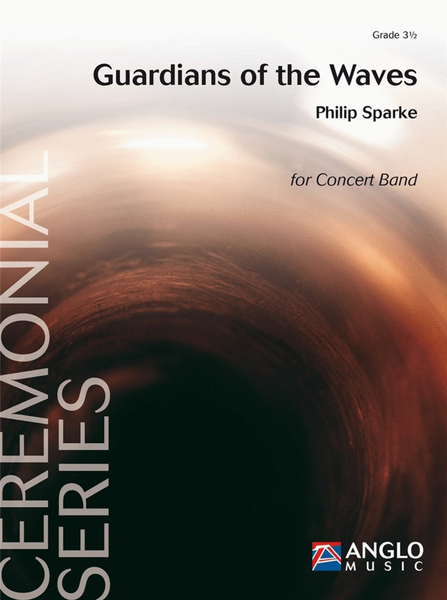Guardians of the Waves
-
Ships in 2 to 3 weeks
Details
Description
SKU: BT.AMP-481-140
Composed by Philip Sparke. Ceremonial Series. Concert March. Score Only. Composed 2021. 32 pages. Anglo Music Press #AMP 481-140. Published by Anglo Music Press (BT.AMP-481-140).English-German-French-Dutch.
Guardians of the Waves was commissioned by the Japan Coast Guard Band to celebrate their 30th anniversary in 2018. They gave the premiere as part of a 30th anniversary concert on November 8th that year. Set in traditionalmarch form, Guardians of the Waves opens with a short introduction, which leads to the main theme, played initially by the brass and then repeated with a florid woodwind descant. The theme is extended and morphs into asecond theme, first played tutti and then quietly repeated by bassoon, tenor sax and euphonium. This leads to a conventional ‘bass strain’, played twice with varying accompaniments. A quieter trio section follows, delicatelyscored and featuring the tenor instruments of the band. Taken up by the full band, this leads back to a recall of the introduction and a return to the main two themes, which lead to a triumphal close.
Guardians of the Waves werd geschreven in opdracht van de Japan Coast Guard Band ter gelegenheid van het dertigjarig bestaan van dit orkest, in 2018. De première vond plaats tijdens het jubileumconcert op 8 november van datjaar. Het werk, dat is gecomponeerd in een traditionele marsvorm, begint met een korte introductie die het hoofdthema inleidt, dat aanvankelijk wordt gespeeld door het koper en dan wordt herhaald met een weelderige discant in hethout. Het thema wordt voortgezet en gaat over in een tweede thema, eerst tutti gespeeld en rustig herhaald door fagot, tenorsax en eufonium. Dit thema voert ons mee naar een conventionele baslijn, die twee keer wordt gespeeld metvariërende begeleiding. Daarna volgt een kalmer triogedeelte, dat delicaat is getoonzet en waarin de tenorinstrumenten van het orkest ruimschoots aan bod komen. Het wordt dan overgenomen door het complete orkest en brengt onsterug naar de inleiding en de twee hoofdthema’s, uitmondend in een triomfantelijk slot.
Guardians of the Waves wurde von der Japan Coast Guard Band anlässlich ihres 30-jährigen Bestehens im Jahr 2018 in Auftrag gegeben. Die Uraufführung fand am 8. November 2018 im Rahmen eines Jubiläumskonzertes statt.Guardians of the Waves wurde als traditioneller Marsch komponiert und beginnt mit einer kurzen Einleitung, die zum Hauptthema führt. Dieses wird zunächst von den Blechbläsern gespielt und dann von den Oberstimmen in denHolzbläsern mit Verzierungen wiederholt. Das Thema wird erweitert und geht in ein zweites Thema über, das zunächst vom Tutti gespielt und dann von Fagott, Tenorsaxophon und Euphonium leise wiederholt wird. Anschließend erklingteine traditionelle Melodie in den Bassinstrumenten, die mit unterschiedlicher Begleitung zweimal gespielt wird. Es folgt ein ruhigeres Trio, das zart besetzt ist und die Tenorinstrumente des Blasorchesters hervorhebt. Dies wirdschließlich vom gesamten Blasorchester aufgegriffen und führt zu einer Wiederholung der Einleitung und einer Rückkehr zu den beiden Hauptthemen, die in einen triumphalen Schluss überleiten.
Guardians of the Waves est une commande de l’Harmonie de la Gendarmerie maritime du Japon pour marquer son 30e anniversaire, en 2018. L’orchestre a créé l’œuvre dans le cadre d’un concert d’anniversaire le 8 novembre decette même année. Écrite en forme de marche traditionnelle, Guardians of the Waves s’ouvre avec une courte introduction qui mène au thème principal, interprété d’abord par les cuivres puis repris avec un déchant fleuri parles bois. Le thème est prolongé et se morphe en un second thème, d’abord en tutti, puis répété doucement par les bassons, saxophones ténor et euphoniums. Ce passage mène une mélodie conventionnelle dans les graves, jouée deuxfois avec divers accompagnements. Vient ensuite un trio plus calme, orchestré avec délicatesse et mettant en avant les instruments ténor. Repris par l’orchestre entier, ce passage est suivi d’un rappel de l’introduction avant unretour aux deux thèmes principaux, qui mènent une conclusion triomphale.

 Share
Share